| |||||||
| Search Forums |
| Advanced Search |
| Go to Page... |
 |
| Search this Thread |  55,427 views |
| | #1 |
| BHPian Join Date: Nov 2008 Location: Pune
Posts: 809
Thanked: 1,177 Times
| Sukhoi Su-27 Flanker : Russia's Eagle Killer The story of the Su-27 began in the late 1960s when Russian intel reported new generation of fighters being developed by the US, with vastly improved capability. The Russians set about beginning development of their own fighters to counter the new upcoming threat. The American fighter turned out as the F-14, F-15, and F-16. Of these, the primary focus was on matching or improving upon the expected performance of the F-15, which was to be the mainstay of the USAF. Aerodynamic studies were performed by TsAGI, the Russian equivalent of NASA, with the outcome being a generic draft of low slung twin engine frame with extensive wing-body blending in the form of leading edge root extenstions, or LERX for short. The wings didn't just abruptly join the cylindrical fuselage as earlier designs did, the wings themselves grew thicker and changed form, getting rounded to blend in seamlessly into the fuselage. This gave a tremendous increase in lifting surface as well as increased internal volume for fuel/equipment. The first mockups were wind-tunnel tested in the early 1970s, the new layout seemed promising. By 1972, the F-15 had made its first flight, and in 1976, a stripped down F-15 called the Streak Eagle, made several world records for climb/altitude performance. The Russians now had a clearer idea of the target performance the Su-27, or the T-10 as the prototype was then named, had to improve on. The project was headed by Mikhail Simonov, with Alexander Pulenko as test pilot.  The T-10 had ogive curved wing tips, no slats, and the twin tails sat atop the twin engine nacelles. 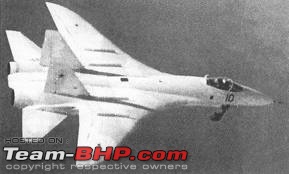 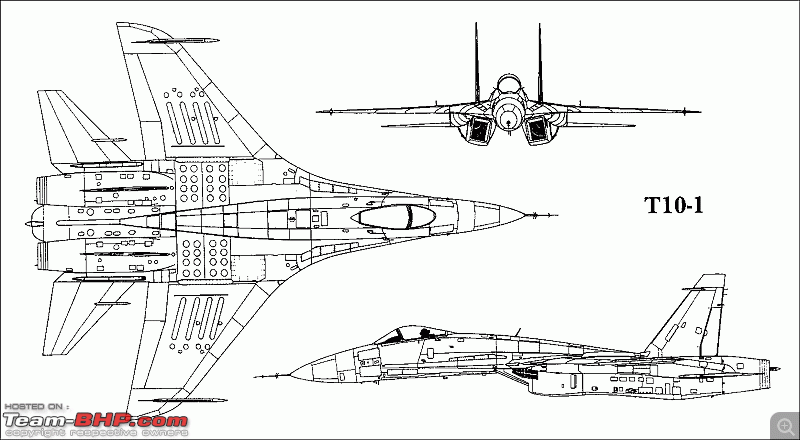 The initial development was carried out as Ramenskoye facility, and US spy satellites captured grainy images of the new fighter. The US intelligence named this fighter Ram-K , the MiG-29 being developed beside the Sukhoi was designated Ram-L, after the parent Ramenskoye base. NATO satellite spy image  The T-10 protoype first flew in 1977. Performance was found deficient compared to the F-15, and a redesign was ordered. The revised design was named T-10S, which significantly changed the original design. The ogive wing-tips gave way to square tips, the engine was reconfigured with the accessories moved to dorsal side of the engine to reduce the engine's ventral wetted area, and the tail fins were moved outboard on the booms which housed the wing root, undercarriage and stabilator controls. Thus was born the Su-27 as we now know. This T-10S prototype flew in 1981 and proved much better in all performance aspects.    The Su-27 series are manufactured at 3 difference organizatios/facilities in Russia - (Irkutsk) IAPO, (Komsomolsk) KNAAPO and NAPO (Novosibirisk). The Su-27 entered service with the Russian air force in 1985, and soon enough NATO planes had their "friendly" encounters in the Cold War. Evident from this photo is the visibility the pilot has outside. The low sill offers a good line of sight below and side, front visibility too is excellent. Rear visibility is not as good as the US F-15/F-18 at 6'o clock position directly behind, but the pilot can most of his rear hemisphere in the same plane and upper hemisphere - certainly a huge improvement over earlier generation jets like the MiG-23 and MiG-25/31, which have little glass area and about nil rear vision.  Remember the Streak Eagle mentioned earlier? The Russians did their own version with the Su-27, naming it the P-42. Like the F-15 Streak Eagle, the Su-27 was stripped of all military equipment - radar, ECM, fire control systems, gun, ammo drum, even paint to reduce weight to bare minimum. Paint alone weighs around 200kg. The tail fin was clipped as well. With the weight now down by about 50%, the thrust to weight ratio of the P-42 exceeded 2:1, and the jet could accelerate in a vertical climb! The P-42 captured several time-to-altitude records from the Streak Eagle in 1986, and those records still stand.   Here's a short video about the P-42. 2 seat Su-27UB/Su-30 with raised cockpit and spine: 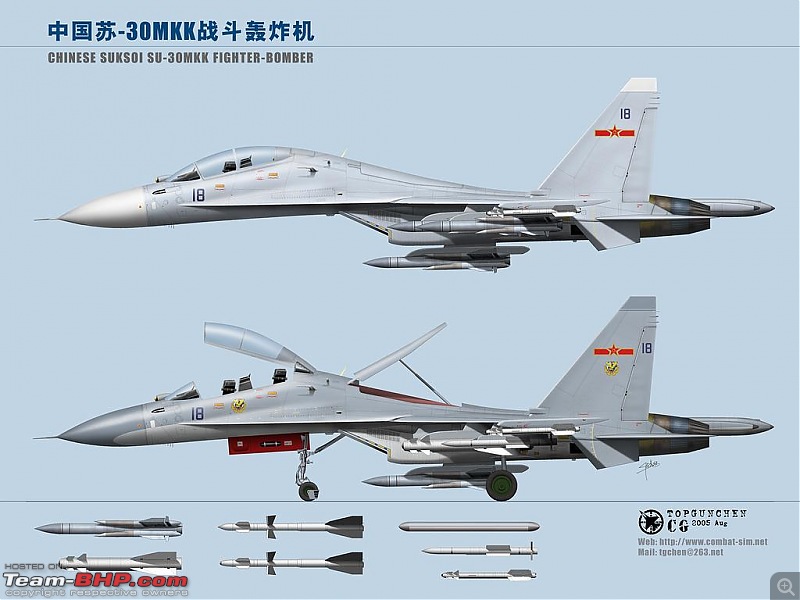 Su-33 plan view:  Specifications: Length: 21.9 m (72 ft) Wingspan: 14.7 m (48 ft 3 in) Height: 5.92 m (19 ft 6 in) Wing area: 62 m² (667 ft²) Empty weight: 16,380 kg (36,100 lb) Loaded weight: 23,430 kg. (51,650 lb.) with 56% internal fuel Max. takeoff weight: 30,450 kg (67,100 lb) Powerplant: 2 × Saturn/Lyulka AL-31F turbofans Dry thrust: 7,670 kgf (75.22 kN, 16,910 lbf) each Thrust with afterburner: 12,500 kgf (122.6 kN, 27,560 lbf) each Fuel capacity: 9,400 kg (13200 litres) Su-27 internally 10,000kg (14000 litres) Su-35 Performance Maximum speed: At altitude: Mach 2.35 (2,500 km/h, 1,550 mph) At sea level: 1,400 km/h, 870 mph Range: 4000 km ( 2480 mi ) at altitude , 1500km (935 mi) at sea level) - Su-27/Su-35 3,530 km (2,193 mi, 1,906 nmi) at altitude; (1,340 km / 800 mi at sea level) - Su-30 Service ceiling: 19,000 m (62,523 ft) Rate of climb: 300 m/s[101] (59,000 ft/min) Wing loading: 377.9 kg/m² (444.61 kg/m² with full fuel) (77.3 lb/ft² with 56% fuel) Thrust/weight: 1.07 with 56% internal fuel; 0.907 with full fuel Maximum g-load: +9 g Armament : Su-27 : 10 hard points - 2 on fuselage centreline, 1 under each intake nacelle, 2 under each wing, plus 2 wingtip rails. internal single barrel GSh-301 cannon on right wing root, 150 round capacity The max load is 2x R-73 on wing tips + 2 R-73s on outboard wing pylons, 2 R-27R/ER on fuselage centre-line, and 2 R-27R/ER beneath engine nacelles, 2 R-27T/ET on wing inboard pylons. Total mix : 4 R-73 + 6 R-27. Also used were longer ranged R-27EA (active radar homing) , R-27EP (passive radar homing) variants of the R-27. Ground attack capability in early Su-27s was limited to unguided bombs and rockets. Su-30/33/35 : 12 hard points - 2 on fuselage centreline, 1 under each intake nacelle, 3 under each wing, plus 2 wingtip rails. upto 8000kg of ordnance including R-77 and R-27R/T/ER/ET/EA/EP medium range air to air missiles, R-73 short range AAMs, KAB250/500/1000kg bombs, laser guided bombs, 80mm/130mm/240mm rockets, Kh-29 , Kh-31, Kh-25, Kh-59 air to ground/ship missiles internal single barrel GSh-301 cannon on right wing root, 150 round capacity Countermeasures ( flares, chaff) cartridges in dorsal surface of the stinger, between the engines. Sources: 1. https://en.wikipedia.org/wiki/Sukhoi_Su-27 2. http://www.milavia.net/aircraft/su-2...7_variants.htm 3. http://www.milavia.net/aircraft/su-27/su-27_history.htm 4. http://www.globalsecurity.org/milita...ssia/su-27.htm 5. www.bharatrakshak.org 6. http://knowaircrafts.blogspot.in/201...7-flanker.html 7. https://en.wikipedia.org/wiki/Sukhoi_Su-30MKI 8. http://www.independent.co.uk/news/ob...y-2240870.html Image sources: 1. wikipedia.org 2. dailytech.com 3. airliners.net 4. russianplanes.net 5. su-27flanker.com 6. www.flankers-site.co.uk 7. http://www.aer.ita.br Last edited by Ricci : 27th September 2015 at 21:31. |
| |  (20)
Thanks (20)
Thanks
 |
| The following 20 BHPians Thank Ricci for this useful post: | .anshuman, ashpalio, digitalnirvana, dodge3p, dr. sen, drive2eternity, GTO, Insearch, itwasntme, Jakku, mnvvishwa, motorpsycho, Peterf, Prashobmdas, RoadSurfer, S2!!!, silversteed, SmartCat, V.Narayan, virtualdanger |
| |
| | #2 |
| BHPian Join Date: Nov 2008 Location: Pune
Posts: 809
Thanked: 1,177 Times
| re: Sukhoi Su-27 Flanker : Russia's Eagle Killer The Su-27 and MiG-29 are similar looking at a glance, as might be expected since they derive from the same TsAGI study. But there are differences in the details, and it's surprising that the MiG-29 design is a stable design, with hydraulic assisted controls and no fly-by-wire, whereas the T-10S derived Su-27 is unstable and featured analog fly-by-wire, like the F-16. As a result, the Su-27 has agility that belies its size.  The characteristic droop-nose allows better downward vision and larger radar, with a 1 meter diameter, a 240km search range and 185km tracking range on the baseline Su-27. Employing a bubble canopy with low sill, the pilot has excellent outward visibility. Some systems are common with the MiG-29, such as the K-36D ejector seat, the helment mounted targeting sight and infra-red search & track mounted just ahead of the windscreen. Early Su-27s has the IRST along the centreline, later models like Su-30/35 have it offset to the right. Two seater variants have stepped seating with rear section of cockpit raised and second crew sitting higher, looking over the pilot in front. There is a resultant increase in drag due to larger wetted area, but fuel capacity is largely retained.   The cropped delta wings are swept 42º, featuring full length leading edge slats, with one surface trailing edge flaps inboard also doubling as ailerons. Wingtips can carry either an ECM pod each, or missile rail for short range AAM. Wings have 2 underwing ordnance stations each, with Su-30/35 gaining an additional wing station. Unlike the MiG-29, there are no overwing louvre intakes, with a mesh grill closing the intakes to minimize FOD. The intakes are also higher above ground with pylons for missile carriage, thus also benefiting in terms FOD susceptibility.   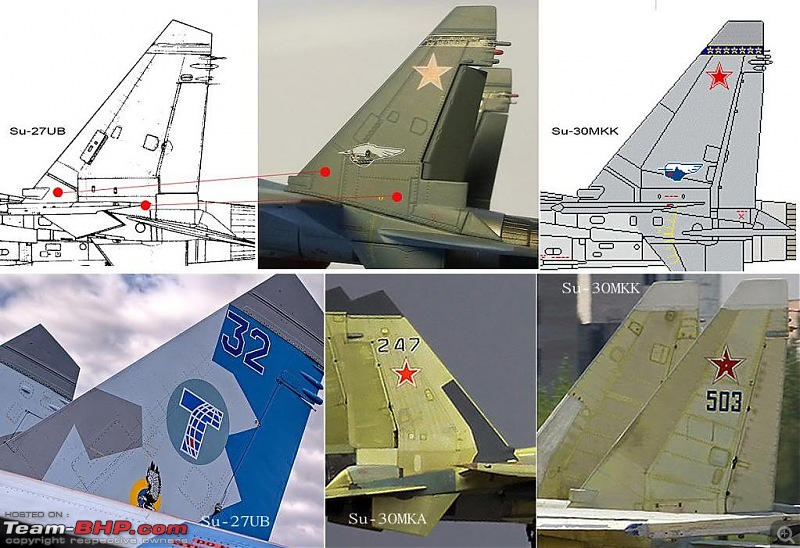 Vertical tail fins are placed on booms outboard of engines, well ahead of exhaust nozzles for better stability at high angle of attack (F/A-18 similarly has tail fins placed ahead). Stabilators can act differentially to allow roll control.  Like the MiG-29, the pilot has a switch to turn off AoA (angle of attack) limiter, that allows the jet to exceed the soft-limit of 26º alpha, to perform special maneuvers like the cobra, bell, hook. A large air brake on the dorsal spine operates hydraulically.  The airframe is largely metal, with significant use of titanium for engine/nozzle and carbon composites for wing/tail skins. On later variants like the Su-35, the stinger ( tail boom extension between the engines) houses rear looking radar, which reportedly enables firing AAMs in the rear hemisphere. The stinger houses brake parachute, fuel jettison outlet and , on the Su-33, tail hook mechanism. Su-33 has shorter tail boom to reduce chance of colliding with ship deck on landing/take off. Su-34 conversely gets longer and thicker stinger, with more fuel.   Nose landing gear retract forward into nose below the cockpit, the nose employing a single wheel on the Su-27, with the more advanced variants (Su-33, Su-35) utilizing twin nose wheels to spread the extra weight of the heavier radars. Only the nose strut features twin landing lights. Main wheels retract forward, rotating to lie flat inside upper part of LERX-wing and intake nacelle junction. 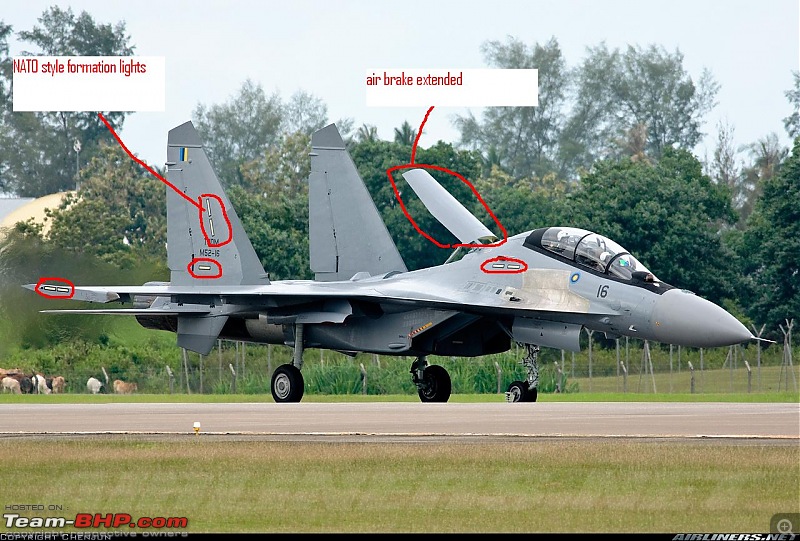 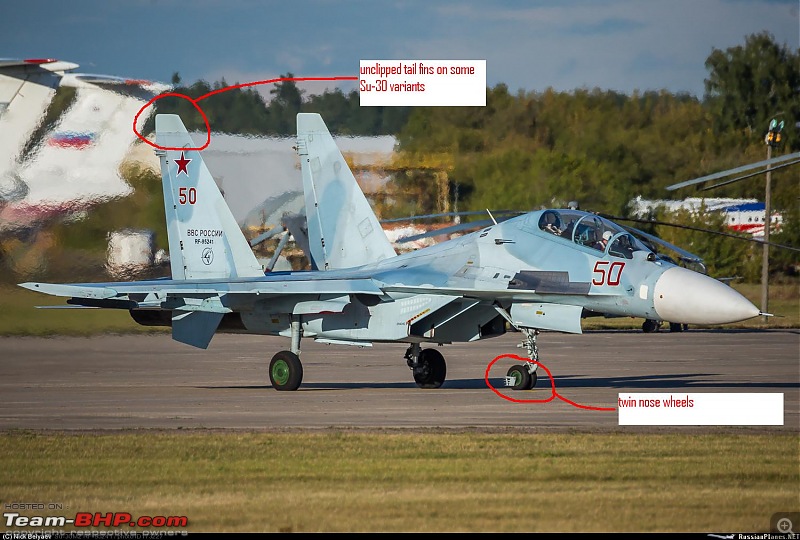 The Su-27 is unique in Russian aviation in that it has no external fuel tanks. The Su-27 has a high fuel fraction, with 9400kg of fuel for an 18000kg empty weight, allowing a fuel fraction of over 50%. Most fighters have fuel fractions in the range of 30-35%. This gives the Su-27 a significant persistence advantage, and as the fuel is burnt, the thrust to weight ratio benefits without the disadvantages of carrying external drop tanks. Except for Su-27SKM variant, which can carry a 2000 litre drop tank on inboard wing station , there is no plumbing for drop tanks, although inflight refuelling probes are present.   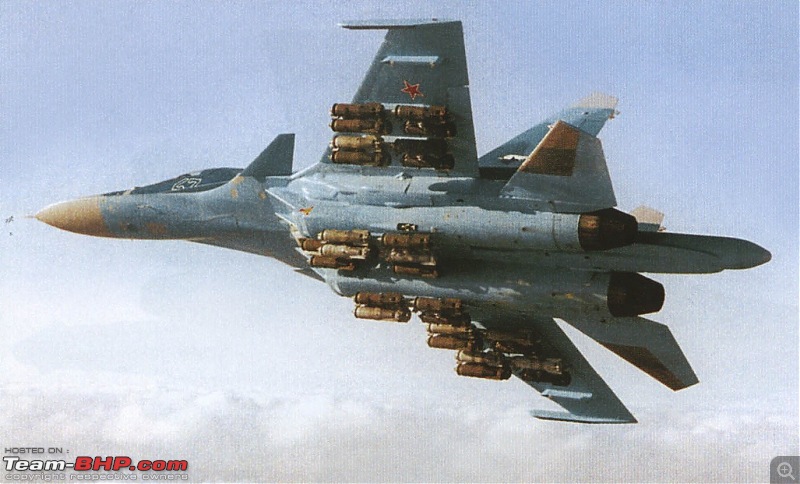 The modern Su-27SM/Su-35/Su-30MK feature more advanced radars, either the Bars or Irbis phased array radars, which improve the radar's range and resolution, to over 350km claimed. The claimed range of the rear-looking radar on the Su-35 is ~35km. These radars being heavier, the nose gear have 2 wheels instead of 1, and canards to counter the heavier nose by advancing the centre of lift ahead. There is a drag penalty due to the canards, with reported top speed being around Mach 2.1-2.2 compared to the Mach 2.35 for the regular LERX Su-27/35s.   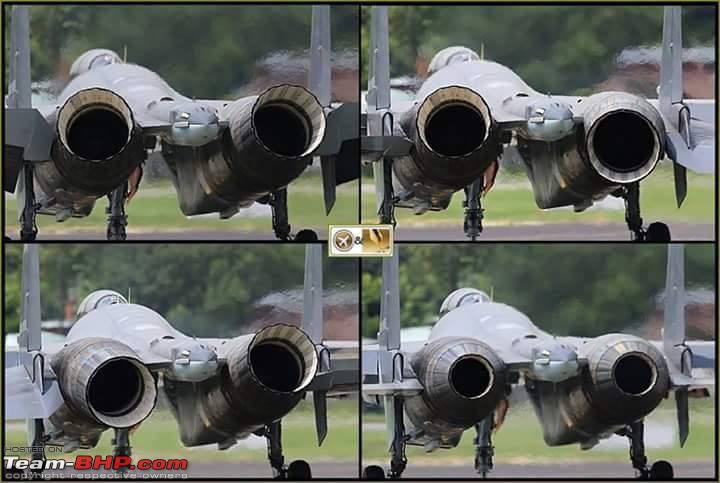 Another enhancement is the 2D thrust vectoring nozzle on the AL-31FU engine. The vector axis is offset 15º outward from the vertical, which in differential operation permits some roll and yaw control. There were trials with a rectangular/flat nozzle like the F-22 to reduce IR signature, but those were found unsatisfactory in terms of thrust loss and abandoned.  Last edited by Ricci : 27th September 2015 at 20:32. |
| |  (18)
Thanks (18)
Thanks
 |
| The following 18 BHPians Thank Ricci for this useful post: | .anshuman, ashpalio, Ayr70n_5enna, digitalnirvana, dr. sen, drive2eternity, GTO, ike, mnvvishwa, navin, Peterf, Prashobmdas, quickdraw, sarathlal, silversteed, SmartCat, V.Narayan, virtualdanger |
| | #3 |
| BHPian Join Date: Nov 2008 Location: Pune
Posts: 809
Thanked: 1,177 Times
| re: Sukhoi Su-27 Flanker : Russia's Eagle Killer Major Variants: P-42 - stripped down Su-27 for world record attempt Su-27P - the early single seat Su-27 fighters, with limited air-ground capability. Su-27UB - 2 seat trainer with full combat capability Su-27K - carrier based variant of the Su-27, renamed Su-33. Features canards, shorter tail stinger, stronger undercarriage, tail hook and folding wings/stabilators Su-27KUB - carrier based trainer variant with side-by-side seating for visibility on carrier approach Su-27SM - modernized Su-27 Su-27SKM - export single seater variant Su-35 - modernized variant of Su-27SM - some prototypes had canards, production Su-35s do not. Su-37 - more advanced development of Su-35 with thrust vectoring nozzles and higher thrust (14500kg) AL-41 engines Su-27PU - two seat interceptor variant of the Su-27, precursor to the Su-30 Su-30 - two seat multirole variant of the Su-27. Additional letters/numbers mark incremental modificiations and customer nation MK = modernized, kommercial/export MKK = MK for China, MKI = MK for India, MKM = MK for Malaysia, Su-34 - two seat strike variant with duck-bill styles front/nose section, side-by-side seating, longer tail stinger, twin main wheels Full list of variants : http://www.milavia.net/aircraft/su-2...7_variants.htm Su-33 aka Su-27K The navalized variant with folding wings, folding stabilators, stronger landing gear, canards and shorter stinger with tail hook. The canards as now seen and made famous by the Su-30/35/37 were first adopted on the Su-33 to improve low speed handling and control , where lower air speed for carrier landing and take off performance is even more important, as also the twin nose wheels to withstand harder landings. The land based Su-30/37 only adopted canards to counter the heavier radars in the nose that caused balance to be upset, so the canards offered a solution in generating more life further ahead to counter the added weight. Production Su-35s in Russian service have a lighter radar, so the canards were not used on those. The canards impose some weight and drag , but low speed control is enhanced, allowing dazzling performance at air shows with post-stall maneuvers, though there is a school of thought - USAF foremost - that slow is a sitting duck, and speed is life. It's called the energy-maneuverability theory created by Col John Boyd, whose input was most notably used to be incorporated in the F-16 design (and F-15 but to lesser extent since the USAF wanted a big, fast powerful interceptor against Boyd's recommendation for small, light, agile fighters). I won't speak much of the energy-maneuverability theory in this thread, suffice to say it has its merits and is far from useless/inaccurate. Nevertheless, a real life incident occurred in 1992 when Russian pilots in Su-27s were invited to the USA as an exercise. The USAF flew F-15Cs, and though there were no dogfights or BVR encounters officially, during a particular sortie involving senior USAF pilots in the back seat (of Su-27UB and F-15D) , in a 1 vs 1 scenario , first with the Su-27 in chase (advantage position) behind the F-15. The F-15 could not shake him off. The engagement was called off after a couple of minutes. A second engagement was conducted with the F-15 in position of advantage behind the Su-27's 6'o clock. After a few turns, the Su-27 was on the F-15's 6'o clock without the F-15 obtaining a firing solution , and again could not shake the Su-27 off its 6. The same incident, has also been refuted by the Americans ( read here ).   The 2 seater has side-by-side seating instead of front-rear.  Su-34: The versatility of the Su-27 platform is such that the Russians decided to build a heavier strike/bomber variant of the Su-27 , initially developed as Su-27IB or Su-32. The heavier frame has dual wheels in the main landing gear, with crew access from the nose wheel well.   Crew sit side by side, with a wide duck-bill styled nose. The empty weight of the Su-34 is approx 22,000kg. Payload is reported to be up to 12,000kg against the Su-30/35's 8000kg. Yet this is an agile bomber that can carry medium range AAMs like the R-77 and R-27, as as well as R-73s. With expended ordnance and fuel used up, it also gains on thrust:weight ratio. A bomber that can fight back ! 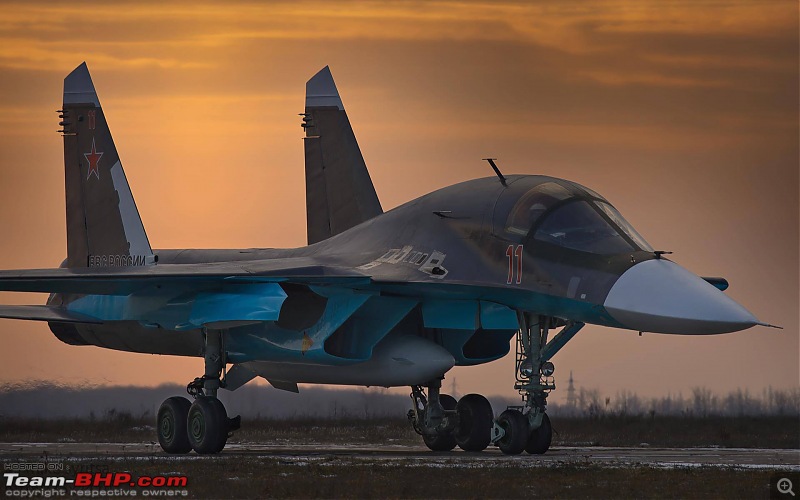 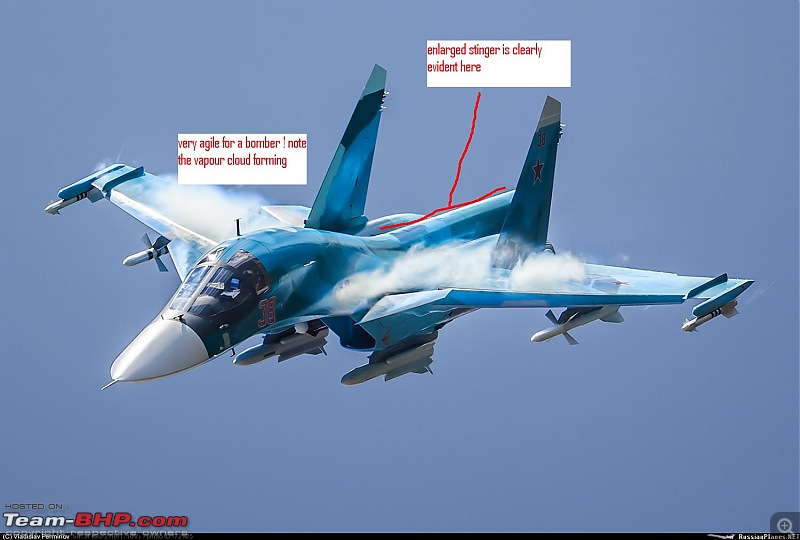   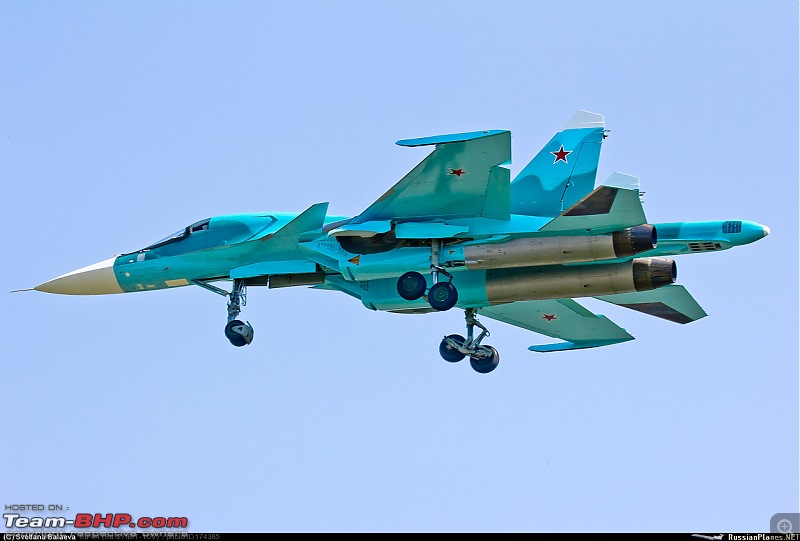 ----------------------------- IAF service: The Indian Air Force decided on purchasing the Su-30 in light of China's purchase of Su-27s. The MiG-29 and Mirage 2000 were sufficient for PAF F-16s, but Su-27 in PLAAF service was a major threat requiring a more capable aircraft. The contract was signed in 1996, the first Su-30MKs (without canards and most of the customized avionics) were delivered in 1997. Lohegaon AFB was the first to receive the Sukhoi, only the second Sukhoi after the Su-7 of the 1960s. The revised jets, with Israeli, French and Indian mix of avionics arrived in 2001, and these bear the canards as well. Initial order was for 230 aircraft, subsequently raised to 272 in light slow acquisition of other aircraft replacements and the need to keep force numbers up, and some attrition losses. Although the IAF's biggest, baddest, most advanced fighter , there have been problems with spares supply from Russia. Our Sukhois come from the Irkutsk factory, supposedly the better factory with better build quality and consistency. The Su-30 has been known to have some engine reliability problems, and at least 1 crash was reported due to engine problems. There have been other issues regarding uncommanded ejections that have caused a crash and a death of a maintenance crew when the ejector seat fired on ground during maintenance - this might have been due to negligence on safety though. Nonetheless, the Su-30 has among the best crash/safety record in the IAF. Su-30MKI squadrons Bareilly AFS: 15 Wing's 8 Eight Pursoots (since mid-2007) & 24 Hunting Hawks sqns with Su-30MKI Bhatinda AFS: 34 Wing – 17 SQN Golden Arrows with Su-30MKI (since June 2012) Chabua AFS: 14 Wing – 102 SQN Trisonics with Su-30MKI (since 8 March 2011) Halwara AFS: 34 Wing – 220 SQN Desert Tigers with Su-30MKI (since 25 September 2012) Jodhpur AFS: 32 Wing – 31 SQN Lions with Su-30MKI (since 1 October 2011) Pune/Lohegaon AFS: 2 Wing – 20 SQN Lightning (since 27 September 2002) and 30 SQN Rhinos with Su-30MKI (since 21 March 2005) Tezpur AFS: 11 Wing – 2 SQN Winged Arrows with Su-30MKI (since 15 June 2009) Gwalior AFS: 40 Wing - TACDE with Su-30MKI (since October 2010)  The blue afterburner plume 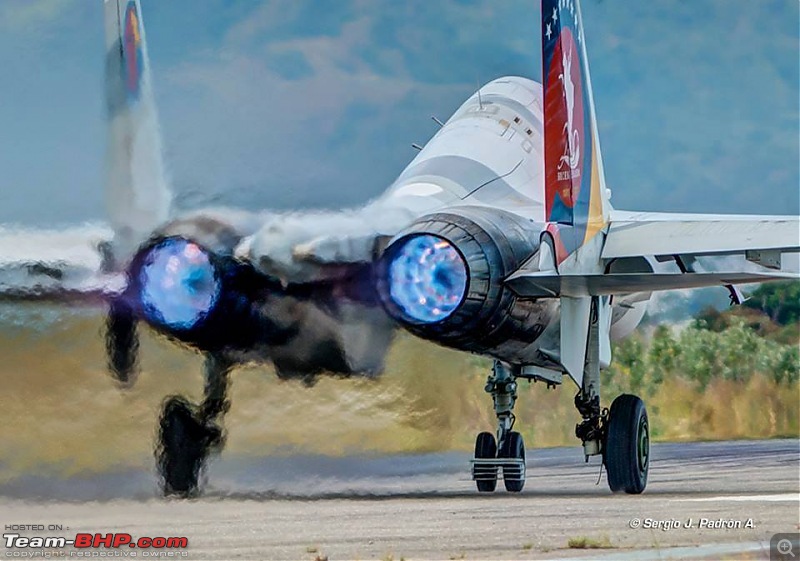  Notice that many of the pictures of the Su-27/30/35 show blue flames when employing afterburners. Most of the time, you see afterburner plumes being yellow-orange. The color of the flame indicates efficient burning of fuel in an oxygen rich flow, thus running a hotter (more blue than yellow) plume. The Su-27's AL-31 engine is regarded as highly efficient, with a bypass ratio of 0.8-0.9, similar to late model P&W F-100-PW-229 engines.   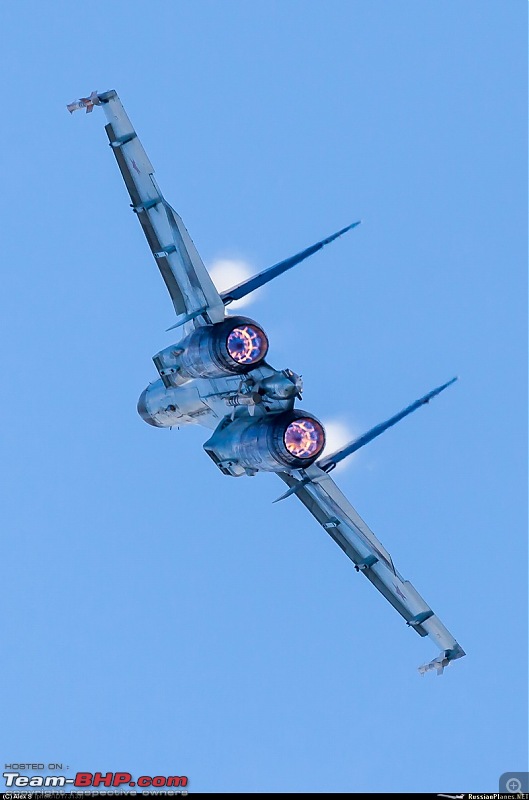 Some nice airshow snaps:   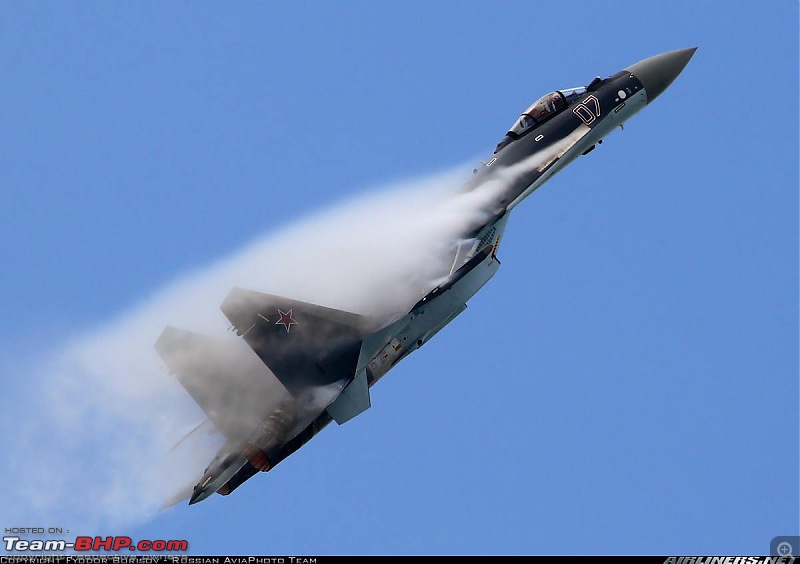 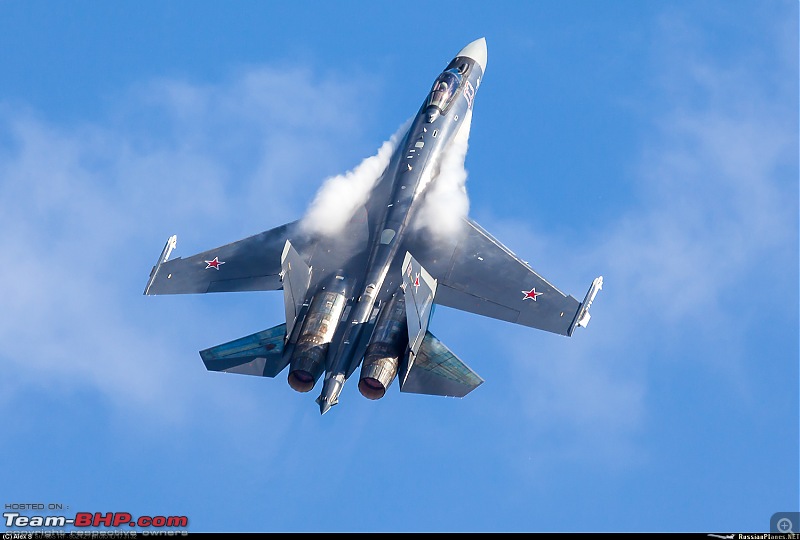  Aerobatic displays : Su-35 and Su-37 Last edited by Ricci : 27th September 2015 at 21:51. |
| |  (39)
Thanks (39)
Thanks
 |
| The following 39 BHPians Thank Ricci for this useful post: | .anshuman, ashpalio, AVR, Ayr70n_5enna, digitalnirvana, Divya Sharan, dr. sen, drive2eternity, firstguri, Foxbat, GTO, ike, jeetaman, john doe, khoj, Kool_Kid, mac187, mnvvishwa, navin, NirmalK, Peterf, quickdraw, rakesh_r, RoadSurfer, roy_libran, RWD, S2!!!, sagarpadaki, sajusherief, sarathlal, sayakc, SmartCat, Sudhindra, SunnyBoi, Swerve, Turbo_asd, V.Narayan, virtualdanger, wbd8779 |
| | #4 |
| Team-BHP Support  | Re: Sukhoi Su-27 Flanker : Russia's Eagle Killer Thread moved out from the Assembly Line Section. Thanks for sharing! |
| |  (1)
Thanks (1)
Thanks
 |
| The following BHPian Thanks GTO for this useful post: | digitalnirvana |
| | #5 |
| BHPian Join Date: Feb 2013 Location: Mumbai
Posts: 344
Thanked: 505 Times
| Re: Sukhoi Su-27 Flanker : Russia's Eagle Killer Let me be the first to Thank You for the compilation. I have always been a great fan of the SUKHOI fighters. Hence the handle!! I am not so technically knowledgeable on fighter aircrafts, but just the design and seeing the aircraft fly has made me a big fan. There is a lot to read about in this article which I am sure will give me a greater insight into this awesome fighter plane. Thanks!! |
| |  (1)
Thanks (1)
Thanks
 |
| The following BHPian Thanks sukhoi30 for this useful post: | Ricci |
| | #6 |
| BHPian Join Date: Jul 2009 Location: Pune-Bangalore
Posts: 807
Thanked: 203 Times
| Re: Sukhoi Su-27 Flanker : Russia's Eagle Killer Brilliant facts and figures. Thanks for sharing. Why didn't India procur the SU-27 ? The SU-30 MKI is proving its mettle but why wasn't the SU-27 purchased. |
| |  (1)
Thanks (1)
Thanks
 |
| The following BHPian Thanks ambivalent_98 for this useful post: | Ricci |
| | #7 |
| BHPian Join Date: Feb 2008 Location: Chennai
Posts: 778
Thanked: 542 Times
| Re: Sukhoi Su-27 Flanker : Russia's Eagle Killer
The SU-30 belongs to the SU-27 family, it is a variant of the SU-27 with some improvements and modifications. Not only did it have better engines and systems than the original SU-27, but the IAF specifically wanted a two-seat version so that the workload is shared between two pilots. Last edited by GTO : 29th September 2015 at 11:55. Reason: First line isn't required. Do NOT be rude to fellow members |
| |  (1)
Thanks (1)
Thanks
 |
| The following BHPian Thanks chncar for this useful post: | Ricci |
| | #8 |
| BHPian Join Date: Sep 2015 Location: Faridabad
Posts: 45
Thanked: 81 Times
| Re: Sukhoi Su-27 Flanker : Russia's Eagle Killer Brilliant thread. Sukhoi 30 MKI is the pride of Indian Airforce.  The proposed addition of Brahmos missile will make Su 30 MKI even more lethal. One of the best plane for Dog fights(WVR),although imagining dog fights in current scenarios is difficult. Cheers |
| |  (1)
Thanks (1)
Thanks
 |
| The following BHPian Thanks Peterf for this useful post: | Ricci |
| | #9 |
| BHPian Join Date: Oct 2013 Location: Mumbai
Posts: 29
Thanked: 14 Times
| Re: Sukhoi Su-27 Flanker : Russia's Eagle Killer Oh, Ricci! What a wonderful thread! Thank you for sharing. It certainly gave me goosebumps. Cheers, mate! |
| |  (1)
Thanks (1)
Thanks
 |
| The following BHPian Thanks Ayr70n_5enna for this useful post: | Ricci |
| | #10 |
| BHPian Join Date: Jun 2005 Location: ERNAKULAM
Posts: 962
Thanked: 385 Times
| Su 30 has a free run. Here's why Have a look as to why the Sukhoi has a free run. |
| |  (7)
Thanks (7)
Thanks
 |
| The following 7 BHPians Thank drpullockaran for this useful post: | digitalnirvana, GTO, Insearch, Ricci, RoadSurfer, sagarpadaki, V.Narayan |
| | #11 |
| Distinguished - BHPian  Join Date: Aug 2014 Location: Delhi-NCR
Posts: 4,071
Thanked: 64,306 Times
| Re: Sukhoi Su-27 Flanker : Russia's Eagle Killer Dear Ricci, compliments on a most interesting thread and those awe inspiring photographs. From one aviation buff to another Bravo Zulu. One of the quiet facts of the Su-30MKI is Project Vetrivale which developed a wholly new weapon system+navigation system+electronic counter measures package using Israeli, Russian, French and Indian electronics (or avionics as we call them). Integration must have been a challenge but it works. From conception to the first squadron getting operational was a relatively short (even by Western standards) 6 years and quite an achievement for the DRDO-IAF-HAL joint team. It converted a aerodynamically superb but electronically wise 'lagging behind' aircraft, the Su-27, into a world beater. I wish we procure more than the 272 Su-30's currently on order and make it our mainstay. This was one big defence contract where the Congress (Narasimha Rao) and BJP (Vajpayee) worked together in the national interest and agreed not to let it fall prey to partisan politics. Goes to show that even the DRDO can do wonders when it wants to. There are reports in the press from time to time about engine failures etc. I am sure there will not be smoke without a fire. But our press in the last 15 years has become rather sensationalist with a desire to make every regular problem read like a collapse which it is not. The Russkies have sold a lesser version termed Su-30MKK to our worthy northern neighbor. Only goes to underline that the Indo-Russian equation is a pure cash and carry one now and we should not let the Indira Gandhi-Brezhnev nostalgia carry us away.Till then the Su-30MKI rocks. |
| |  (6)
Thanks (6)
Thanks
 |
| The following 6 BHPians Thank V.Narayan for this useful post: | Amartya, digitalnirvana, drive2eternity, GTO, john doe, Ricci |
| |
| | #13 |
| BHPian Join Date: Oct 2013 Location: All over India
Posts: 36
Thanked: 37 Times
| Re: Sukhoi Su-27 Flanker : Russia's Eagle Killer Thank you for this thread. Lately, these detailed aircraft threads are the ones I wait for with excitement...... Reminds me of my first Su-30MKI sticker that adorned the centre-stage of my hall of stickers in my schooldays! |
| |  ()
Thanks ()
Thanks
 |
| | #14 |
| BHPian Join Date: Jun 2015 Location: Bangalore
Posts: 415
Thanked: 1,841 Times
| Re: Sukhoi Su-27 Flanker : Russia's Eagle Killer Wonderful thread !! Thanks a ton. Reading it really made my day. I remember as a kid, whenever we flew in and out of Pune, my sole aim was to get a glimpse of a Su30. And then, I happened to visit KV Tezpur for some event, and it being in the Air Force station, I ensured to walk up and down the road next to the parked Su30s at least 50 times in 2 day. Love live Su-30MKI ! |
| |  (1)
Thanks (1)
Thanks
 |
| The following BHPian Thanks drive2eternity for this useful post: | digitalnirvana |
| | #15 |
| BHPian Join Date: May 2006 Location: Mumbai
Posts: 732
Thanked: 1,678 Times
| Re: Sukhoi Su-27 Flanker : Russia's Eagle Killer A long documentary describes the whole development process of the Su-27 family in amazing detail. It also explains the basic concepts of aircraft design and delves into the various design choices that have to be made. PS: I like Russian documentaries so much better, they are more informative and less propaganda unlike the one's from USA. |
| |  (3)
Thanks (3)
Thanks
 |
| The following 3 BHPians Thank jalsa777 for this useful post: | digitalnirvana, shan_ned, V.Narayan |
 |


